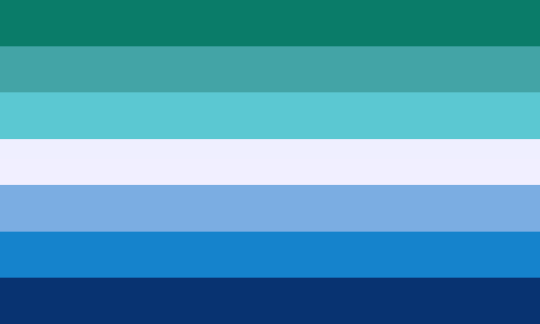

"Bigender, bi-gender or dual gender is a gender identity that includes any two gender identities and behaviors. No matter what else we are, all agender people are wholly equally agender." Description Sources by representing agenderness in one stripe. However, the new flag has a deliberately higher-contrast design with fewer stripes and emphasizes solidarity of agender people who may also be lesbian, gay, bi, nonbinary, trans, ace, etc. They're similar in color scheme (black, gray, white, green). Agender people have no specific set of pronouns singular they is typically used, but it is not the default." "The four-stripe agender flag is an homage to the original, widely-used seven-stripe agender flag created by Salem in 2014. Although this category includes a broad range of identities which do not conform to traditional gender norms, scholar Finn Enke states that people who identify with any of these positions may not necessarily self-identify as transgender. is someone who identifies as having no gender or being without a gender identity.

White acknowledges the historical use as an all-inclusive color for anyone who is non-binary in sex and/or gender and the identity color of black to be placed against to indicate its specific grouping within that traditionally generalized non-binary color." Description Sources The color black for agender persons is chosen for its correspondence with black being the total absence of color in the light spectrum. Black is to indicate a distinct identity in those without gender. Agender people have no specific set of pronouns singular they is typically used, but it is not the default." According to uncited text on Gender Wiki, it was "reated 2014 by Rumpus Parable.
#LIGHT BLUE WHITE LIGHT BLUE FLAG MANUAL#
This process required a small about of manual tweaking for colors on the border between green and blue."An agender person. These 63 colors were then grouped into parent categories of white, black, red, blue, green and yellow using a simple algorithm to determine which parent color each shade most resembled. That reduced the number of distinct shades from 527 to 63.

Because digital images are only approximations of the colors in the physical flags, we decided it was safe to further simplify these colors down to the traditional “web safe” palette of 216 possible colors. This yielded 527 different shades across 36.6 million pixels.
#LIGHT BLUE WHITE LIGHT BLUE FLAG CODE#
The complete code used to generate this data, which uses Mathematica 10, is available on the Wolfram Cloud.Īfter downloading the 196 flag images from, we added up the total number of pixels of each color. In perhaps the most famous example of two countries showing up somewhere wearing the same outfit, Liechtenstein and Haiti both arrived at the 1936 Olympics flying identical banners. Sometimes, it’s not just the colors that seem familiar.


 0 kommentar(er)
0 kommentar(er)
